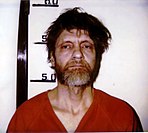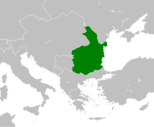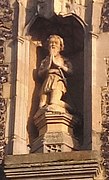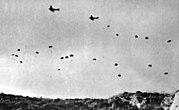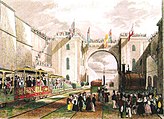Wikipedia:Today's featured article/May 2021
| << | Today's featured articles for May 2021 | >> | ||||
|---|---|---|---|---|---|---|
| Su | Mo | Tu | We | Th | Fr | Sa |
| 1 | ||||||
| 2 | 3 | 4 | 5 | 6 | 7 | 8 |
| 9 | 10 | 11 | 12 | 13 | 14 | 15 |
| 16 | 17 | 18 | 19 | 20 | 21 | 22 |
| 23 | 24 | 25 | 26 | 27 | 28 | 29 |
| 30 | 31 | |||||
May 1
The Socialist Soviet Republic of Abkhazia was a republic within the Caucasus region of the Soviet Union that existed from 1921 to 1931. Formed in the aftermath of the Red Army invasion of Georgia in February 1921, it was independent until December, when a treaty united it with the Georgian Soviet Socialist Republic. In 1931 it was replaced with the Abkhaz Autonomous Soviet Socialist Republic within Georgia. Abkhazia was a major tobacco producer in this era, growing over half of the Soviet Union's supply. It also produced tea, wine, and citrus fruits, and became one of the wealthiest regions in the country. Its sub-tropical climate made it a prime holiday destination; Joseph Stalin and other Soviet leaders had dachas in the region and spent considerable time there. An ethnically diverse region, Abkhazia was nominally led by the Abkhaz people, who made up less than 30 percent of the population. Other major groups included Georgians, Armenians, Greeks, and Russians. (Full article...)
May 2
The Greek case was brought to the European Commission of Human Rights in September 1967. It alleged violations of the European Convention on Human Rights (ECHR) by the Greek junta, which had come to power in a coup and launched widespread political repression. A second case alleging additional violations, including of Article 3 forbidding torture, was added in 1968. In 1968 and 1969, a subcommission questioned witnesses and embarked on a fact-finding mission to Greece. Their report proving systematic torture was leaked to the press and turned European public opinion against Greece. On 12 December 1969, the Committee of Ministers of the Council of Europe considered a resolution to expel Greece. To save face, foreign minister Panagiotis Pipinelis (pictured) denounced the ECHR and walked out. Greece returned to the organization after the Greek democratic transition in 1974. The case was influential as a precedent in human rights jurisprudence, especially for the legal definition of torture. (Full article...)
May 3
The 2020 World Snooker Championship was a professional snooker tournament held from 31 July to 16 August 2020 at the Crucible Theatre in Sheffield. It was originally scheduled to take place from 18 April to 4 May, but qualification and the main rounds were postponed due to the COVID-19 pandemic in the United Kingdom. The event was intended to allow limited live audiences, but apart from the first day and the final it was played behind closed doors. The tournament was organised by the World Snooker Tour, broadcast by the BBC, Eurosport and Matchroom Sport, and sponsored by sports betting company Betfred. It had a total prize fund of £2,395,000, with the winner receiving £500,000. The delayed qualifying rounds took place from 21 to 28 July, involving 128 professional and invited amateur participants. The top 16 reached the main stage of the tournament where they played the top 16 ranked players. Judd Trump, the defending champion, lost in the quarter-final stage to Kyren Wilson. Ronnie O'Sullivan (pictured) won his sixth world title, defeating Wilson 18–8 in the final. (Full article...)
May 4
William Feiner (1792–1829) was a German Catholic priest and Jesuit who became a missionary to the United States and eventually the president of Georgetown College. Born in Münster, he taught in Jesuit schools in the Russian Empire and Polish Galicia as a young member of the Society of Jesus. He then emigrated to the United States several years after the restoration of the Society, taking up pastoral work and teaching theology in Conewago, Pennsylvania, before becoming a full-time professor at Georgetown College. There, he also became the second dedicated librarian of the college's library. Eventually, Feiner became the president of Georgetown in 1826. While president, he taught theology at Georgetown and led the congregation at Holy Trinity Church. Despite being the leader of an American university, he never mastered the English language. Long plagued by poor health due to tuberculosis, his short-lived presidency ended after three years, just weeks before his death. (Full article...)
May 5
The Heart of Thomas is a 1974 Japanese manga series written and illustrated by Moto Hagio (pictured). Originally serialized in Shūkan Shōjo Comic, a weekly manga magazine publishing shōjo manga – manga aimed at young and adolescent women – the series follows the events at a German all-boys school after the suicide of student Thomas Werner. It is one of the earliest manga in the shōnen-ai (male–male romance) genre. While The Heart of Thomas was initially poorly received by readers, by the end of its serialization it was among the most popular series in Shūkan Shōjo Comic. It significantly influenced shōjo manga as a medium, with many of the stylistic and narrative hallmarks of the series becoming standard tropes of the genre. The series has attracted considerable scholarly interest, and has been adapted into a film, a stage play, and a novel. In North America, an English-language translation of The Heart of Thomas, translated by Rachel Thorn, was published by Fantagraphics Books in 2013. (Full article...)
May 6

Mark Saunders was a British barrister who struggled with depression and alcoholism. On 6 May 2008 he repeatedly fired a shotgun from a window of his home in Markham Square, London. When armed police arrived, Saunders fired at their vehicle (example pictured) and a siege began. Saunders fired twice more and police returned fire, slightly wounding him. Saunders then waved the shotgun out of a window in the direction of a group of police officers; seven officers fired eleven shots, of which at least five struck him. Saunders was pronounced dead at a waiting ambulance. An inquest was held where the jury returned a verdict of lawful killing, but found several flaws in the police handling of the incident. They did not consider that any of these significantly contributed to the outcome. They could not decide whether Saunders had intentionally provoked a lethal response ("suicide by cop"). In 2010, the Metropolitan Police created a unit of senior officers to manage similar incidents. (Full article...)
May 7
Frances Gertrude McGill (1882–1959) was a Canadian scientist who was a forensic pathologist, nicknamed the "Sherlock Holmes of Saskatchewan" for her deductive skills and public fame. McGill influenced the development of forensic pathology in Canadian police work. After receiving her medical degree in 1915, McGill moved to Saskatchewan, where she was hired first as the provincial bacteriologist and then as the provincial pathologist. She worked extensively with the Royal Canadian Mounted Police (RCMP) and local police forces for more than thirty years, and was instrumental in establishing the first RCMP forensic laboratory. She directed the RCMP laboratory for three years, and trained new RCMP recruits in forensic detection methods. After retiring in 1946, McGill was appointed Honorary Surgeon for the RCMP by the Canadian minister of justice, becoming one of its first official female members. McGill Lake in northern Saskatchewan was named in her honour. (Full article...)
May 8

Preening is a bird maintenance behaviour that involves using the beak to position feathers, interlock the barbules, clean plumage, and reduce parasites. Feathers contribute to a bird's insulation, waterproofing and flight, so birds spend much time on preening. They may fluff up their feathers to "rezip" the barbules, and use their beaks to gather preen oil from a gland at the base of their tail. They spread the oil by drawing each contour feather through their bills. Ritualised preening has become part of some courtship displays and a displacement activity when birds are subjected to stress. Preening can be a social activity involving two or more birds called "allopreening", which occurs either between a mated pair or flock members in a social species. This may assist in grooming, the recognition of individuals, or reducing conflict. Most allopreening is confined to the head and neck. Ingestion of pollutants or pathogens during preening can lead to health problems. Injury and infection can cause overpreening in caged birds. (Full article...)
May 9
"Mother's Day" is the second episode of the fourth season of the American animated television series Rugrats, first broadcast on May 6, 1997, on Nickelodeon. In this Mother's Day special, Tommy Pickles and Phil and Lil Deville attempt to find the perfect mother for Chuckie Finster, who is being raised by his father Chas. They discover that Chuckie's mother, voiced by Kim Cattrall (pictured), died of a terminal illness. Norton Virgien and Toni Vian directed the episode. "Mother's Day" was praised by critics for its storyline and its representation of breastfeeding, and has been the subject of several retrospective reviews for its treatment of the death of a parent. It won a CableACE Award and was nominated for the Humanitas Prize in the Children's Animation Category. Rugrats received a nomination for the 1997 Primetime Emmy Award for Outstanding Animated Program after Nickelodeon submitted "Mother's Day" for consideration. (Full article...)
May 10
A Crow Looked at Me is the eighth studio album by Mount Eerie, a solo project of the American musician Phil Elverum. Released in 2017, it was composed after his 35-year-old wife, Geneviève Castrée, was diagnosed with pancreatic cancer in 2015 and died in July 2016. Elverum wrote and recorded the songs over a six-week period in the room where she died, mostly using her instruments. The lyrics are presented in a diary-like form and sung in a raw, intimate style. They bluntly detail Castrée's illness and death, Elverum's grief, and his relationship with their infant child. It is soundtracked by sparse folk instrumentation. It was widely praised for its emotional potency. The album went on to be one of the most acclaimed albums of 2017 and of Elverum's career. His following albums, Now Only (2018) and Lost Wisdom pt. 2 (2019), further detail and examine Castrée's illness and early death. (Full article...)
May 11
Ted Kaczynski (born 1942), also known as the Unabomber, is an American domestic terrorist, eco-anarchist and former mathematics professor. He was accepted to Harvard College at the age of 16 and, after graduating and earning his PhD, he taught at UC Berkeley for three years. He then moved to a small cabin in Montana to pursue a simple life. Kaczynski began sending mail bombs to people associated with universities, airlines, and the advancement of modern technology in 1978. He mailed a total of sixteen bombs, killing 3 people and injuring 23 others. Kaczynski's bombing campaign came under investigation by the FBI, who employed over 150 people in the most expensive FBI investigation ever conducted at the time. Kaczynski's manifesto, an anarcho-primitivist essay, was published in The Washington Post on the condition that he would desist from terrorism. He was eventually arrested in 1996 (mug shot pictured) and later imprisoned at ADX Florence in Colorado. (Full article...)
May 12
The Boeing 747 is a large, long-range, wide-body airliner and cargo aircraft manufactured by Boeing Commercial Airplanes in the United States. On September 30, 1968, the first 747 was rolled out of the custom-built Everett Plant, the largest building in the world by volume. The first flight took place on February 9, 1969, and the 747 was certified that December. Entering service with Pan Am on January 22, 1970, it was the first airplane dubbed a "Jumbo Jet". The 747 is a quadjet, with ten-abreast economy seating typically accommodating 366 passengers. It has a pronounced 37.5° wing sweep, allowing a Mach 0.85 (490 kn; 560 mph; 900 km/h) cruise speed. Boeing introduced the 747-200 in 1971, with more powerful engines for a heavier maximum takeoff weight and a longer range. The heavier 747-400 was introduced in 1989 and is the most common variant. By June 2020, 1,556 aircraft had been built. As of 2020, 61 Boeing 747s have been lost in accidents, in which 3,722 people have died. (Full article...)
May 13
Die Hard is a 1988 American action film directed by John McTiernan and written by Jeb Stuart and Steven E. de Souza. It stars Bruce Willis (pictured), Alan Rickman, Alexander Godunov, and Bonnie Bedelia. Based on the 1979 novel Nothing Lasts Forever by Roderick Thorp, Die Hard follows New York City police detective John McClane (Willis) who is caught up in a terrorist takeover of a Los Angeles skyscraper. Filming took place in 1987 and 1988, on a $25–35 million budget. Reviews were mixed, but Die Hard became the year's highest-grossing action film. It received four Academy Award nominations, elevated Willis to leading-man status and made Rickman a celebrity. It is now considered one of the greatest action films. It revitalized the genre, largely due to its depiction of McClane as a vulnerable and fallible protagonist. "Die Hard" became a shorthand for plots in which a hero battles in a restricted environment. It was selected for preservation in the National Film Registry in 2017. (Full article...)
May 14
Several attempts and proposals were made to unify Bulgaria and Romania in the 19th and early 20th centuries, under a federation, a personal union or a confederation. Earlier, Bulgarians and Romanians had lived together under the First Bulgarian, Second Bulgarian and Ottoman empires for centuries. After the establishment in 1878 of an autonomous Bulgarian principality, there were several unsuccessful Romanian nominees for its throne. In 1886, Bulgarian leader Stefan Stambolov tried again to establish a personal union with Romania, and negotiations were conducted. All such proposals ultimately failed because of cultural and political differences and opposition from Austria-Hungary and especially Russia, which even threatened to invade both countries. Approaches to effect a union were attempted again during the communist era, but the Soviet Union strongly rejected them. The accession of both countries into the European Union has led to speculation about a new future revitalization of the idea. (Full article...)
May 15
The Columbia, South Carolina, Sesquicentennial half dollar is a fifty-cent piece struck by the United States Bureau of the Mint in 1936 as a commemorative coin. Designed by Abraham Wolfe Davidson, it marks the 150th anniversary of the designation of Columbia as South Carolina's state capital. The obverse design (pictured) depicts Lady Justice holding a sword and scales, standing between South Carolina's Old State House, built in 1790, and the New State House, completed in 1903. The reverse shows the palmetto tree, South Carolina's state symbol, with 13 stars representing the original Thirteen Colonies, though they may also be intended to represent the Confederate States. The coins were struck in September 1936, but they were slow to be distributed. Once they were, they were sold to the public in small quantities, frustrating coin dealers who hoped to accumulate more to resell to their customers. They generally sell in the range of hundreds of dollars today, depending on condition. (Full article...)
May 16
Apollo 7 (October 11–22, 1968) was the first crewed flight in NASA's Apollo program. It was commanded by Wally Schirra, with command module pilot Donn F. Eisele and lunar module pilot R. Walter Cunningham, and saw the resumption of human spaceflight by the agency after the fire that killed the three Apollo 1 astronauts in January 1967. Determined to prevent a repetition of the fire, the crew spent long periods of time monitoring the construction of their Apollo command and service module (CSM). After liftoff on October 11, 1968, extensive testing of the CSM took place, along with testing of techniques to be used on lunar missions, and also the first live television broadcast from an American spacecraft. Despite tension between the crew and ground controllers, the mission was a complete technical success, giving NASA the confidence to send Apollo 8 into orbit around the Moon two months later, but in part because of those tensions, no member of the crew flew in space again. (Full article...)
May 17
Thomas Erpingham (c. 1355 – 27 June 1428) was an English soldier and administrator who served three generations of the House of Lancaster including two English kings. Through his access to royal patronage he acquired great wealth and influence. During the reign of Richard II he served under the King's uncle John of Gaunt, Duke of Lancaster, in Spain and Scotland, and with John's son Henry Bolingbroke on crusades in Lithuania, Prussia and the Holy Land. On becoming king as Henry IV, Bolingbroke rewarded him with senior appointments. He later helped suppress the Epiphany Rising and was appointed guardian of Henry's second son, Thomas. Erpingham was a member of the Privy Council, acting at one point as marshal of England. In 1415 he served as a knight banneret in Henry V's campaign in France and commanded the archers at the Battle of Agincourt. A benefactor to the city of Norwich, he built the main cathedral gate which bears his name. (Full article...)
May 18
Burnley Football Club is an English association football club based in Burnley, Lancashire. Founded in 1882, it was one of the first to become professional – in 1883. The club entered the FA Cup for the first time in 1885–86 and was one of the 12 founder members of the Football League in 1888–89. The team currently compete in the Premier League, the top tier of English football. Burnley have been champions of England twice, have won the FA Cup once, and the FA Charity Shield twice. They also reached the quarter-finals of the 1960–61 European Cup. Burnley are one of only five teams to have won all four professional divisions of English football. Burnley have played home games at Turf Moor (pictured) since 1883. The club colours of claret and blue were adopted before the 1910–11 season in tribute to the previous season's champions, Aston Villa. The club is nicknamed "the Clarets", because of the dominant colour of its home shirts. (Full article...)
May 19
Angkor Wat is a temple at Angkor, Cambodia, built in the capital city for King Suryavarman II in the early 12th century as the state temple. The largest and best-preserved temple at the site, it is the only one to have remained a significant religious center—first Hindu, then Buddhist—since its foundation. The temple is the epitome of the high classical style of Khmer architecture. It has become a symbol of Cambodia, appearing on its national flag, and is the country's prime attraction for visitors. Angkor Wat combines two basic plans of Khmer temple architecture: the temple mountain and the later galleried temple. It is designed to represent Mount Meru, home of the gods in Hindu mythology. At the center of the temple stands a quincunx of towers. The temple is admired for the grandeur and harmony of its architecture and for the extensive bas-reliefs and the numerous devatas adorning its walls. Unusually, Angkor Wat faces the west; scholars are divided as to the significance of this. (Full article...)
May 20
The Battle of Rethymno was part of the Battle of Crete, fought during World War II on the Greek island of Crete between 20 and 29 May 1941. Two Australian battalions, supported by Greek forces, defended an airstrip and the nearby town of Rethymno against a German paratrooper attack (pictured). Due to confusion and delays at the airfields in Greece, the German assault was launched without direct air support, and drops occurred over an extended period rather than simultaneously. German units dropping near Allied positions suffered very high casualties, both in the air and on the ground. More than 500 Germans were captured, including the local commander. The Germans concentrated their resources on the battle for the airfield at Maleme, 50 mi (80 km) to the west, which they won. The Allies ordered an evacuation of Crete on 27 May, but were unable to communicate this to the units at Rethymno. Faced by a superior force of Germans equipped with tanks and artillery the Australians surrendered on 29 May. (Full article...)
May 21
George Vincent (1796 – c. 1832) was an English landscape artist who produced watercolours, etchings and oil paintings. He is considered to be one of the most talented of the Norwich School of painters, a group of artists inspired by the Norfolk countryside. Vincent's work was founded on the Dutch school of landscape painting and the style of John Crome, also of the Norwich School. The son of a weaver, Vincent was apprenticed to Crome. Vincent exhibited at the Royal Academy and the British Institution. From 1811 until 1831 he showed at the Norwich Society of Artists, exhibiting over 100 pictures of Norfolk landscapes and marine works. By 1818 he had relocated to London, yet struggled financially. He was imprisoned for debt from 1824 to 1827. After 1831, Vincent disappeared and was never found. The art historian Herbert Cundall wrote in the 1920s that had Vincent "not given way to intemperate habits he would probably have ranked amongst the foremost of British landscape painters". (Full article...)
May 22
The opening of the Liverpool and Manchester Railway (L&M), often considered the dawn of modern transport, took place on 15 September 1830. Eight trains set out from Liverpool to Manchester carrying dignitaries including the Duke of Wellington, then prime minister. At Parkside the trains stopped to take on water, and former cabinet minister William Huskisson alighted and was struck by a locomotive, suffering fatal injuries. As a large crowd waiting to meet the trains in Manchester was becoming unruly, Wellington decided that the event should continue. On arrival in Manchester a hostile crowd pelted Wellington with vegetables and he ordered the trains return to Liverpool. Faults meant only four of the locomotives were still functional; the party eventually returned six and a half hours late. The accidents led to significant coverage of the opening, raising the profile of the new technology, and within a month schemes were announced to connect the industrial centres of England. (Full article...)
May 23
A large body of Western Chalukya literature in the Kannada language was produced during the empire's reign (973–1200) in present-day India (map pictured). Kannada literature from this period, usually considered Old Kannada, constituted the bulk of the Chalukya court's textual production and pertained mostly to the socio-religious development of the Jain faith, with some of that of the Shaiva faith. Important literary contributions in the Kannada language came not only from court poets, noblemen, royalty, ascetics and saints who wrote in the marga (mainstream) style, but also from commoners and artisans, including cobblers, weavers, cowherds and shepherds who wrote in the desi (folk) style. These poets revolutionised Kannada literature, rejecting traditional themes that eulogised kings and noblemen, and writing didactic poems that were closer to the spoken and sung form of the language. In addition to hundreds of male poets, over thirty female poets have been recorded. (Full article...)
May 24

Final Fantasy IX is a 2000 role-playing video game developed and published by Squaresoft for the PlayStation video game console. It is the ninth game in the main Final Fantasy series. Players follow the bandit Zidane Tribal, who kidnaps Princess Garnet Til Alexandros XVII of Alexandria as part of a gambit by the neighboring nation of Lindblum. The game was developed alongside Final Fantasy VIII. Envisioned by developers as a retrospective for the series, it departed from the futuristic settings of Final Fantasy VI, Final Fantasy VII, and Final Fantasy VIII by returning to the medieval style of the earlier installments. Final Fantasy IX was released to critical acclaim and is often considered one of the greatest video games of all time. Final Fantasy IX was commercially successful, selling more than 5.5 million copies on PlayStation by March 2016. Ports featuring minor gameplay and graphical enhancements were released for various other platforms in the late 2010s. (This article is part of a featured topic: Final Fantasy series.)
May 25
Operation Rösselsprung was a combined airborne and ground assault by the German XV Mountain Corps on the Supreme Headquarters of the Yugoslav Partisans during World War II. Launched on 25 May 1944, the operation was aimed at the Partisan leader Marshal Josip Broz Tito (pictured) and his headquarters. It is associated with the Seventh Enemy Offensive. The operation involved direct action via an airborne assault by the 500th SS Parachute Battalion and a planned subsequent link-up with ground forces, including Home Guard forces of the Independent State of Croatia and collaborationist Chetniks. Tito, his principal staff and Allied military personnel escaped. The operation failed due to fierce Partisan resistance, the failure of the various German intelligence agencies to share the limited intelligence available on Tito's exact location, and the lack of contingency planning by the commander of the German airborne force. (Full article...)
May 26

Yazid I (c. 646 – 683) was the second caliph of the Umayyad Caliphate, ruling from April 680 until his death. His appointment, the first hereditary succession to the caliphate in Islamic history, was opposed by several Muslim grandees from Medina, including Muhammad's grandson Husayn ibn Ali. Husayn refused to recognize Yazid following his accession and left for Kufa in Iraq to lead a revolt, but was killed in the Battle of Karbala. To suppress the subsequent rebellion in Arabia, Yazid sent an army that captured and sacked Medina. Next, Mecca was besieged for several weeks until the army withdrew as a result of Yazid's death. The caliphate fell into a decade-long civil war known as the Second Fitna, ending with the establishment of the Marwanid dynasty. Yazid is considered an illegitimate ruler and a tyrant by many Muslims. Modern historians consider him a capable ruler, albeit less successful than his father Mu'awiya I, whose style of governance he continued. (Full article...)
May 27
The 2007 Coca-Cola 600 was the twelfth stock car race of the 2007 NASCAR Nextel Cup Series and the 48th iteration of the event in the U.S. It was held on May 27, 2007, before a crowd of 175,000 in Concord, North Carolina, at Lowe's Motor Speedway (pictured), now called Charlotte Motor Speedway, one of ten intermediate tracks to hold NASCAR races. The 400-lap race on the speedway's standard 1.5-mile (2.4 km) track covers the longest distance of any event on the NASCAR calendar. The 2007 race was won by Casey Mears of the Hendrick Motorsports team, who started from 16th position. J. J. Yeley finished second and Kyle Petty came in third. There were thirteen cautions and 29 lead changes among fifteen drivers during the race. Kurt Busch held the lead for 107 laps, longer than any other driver. The 2007 race is Mears's only win in the Nextel Cup Series, now known as the NASCAR Cup Series. (Full article...)
May 28

The menstrual cycle is a series of natural changes in hormone production and the structures of the uterus and ovaries of the human female reproductive system that make pregnancy possible. Naturally occurring hormones drive two concurrent and coordinated cycles that last about 28 days. The ovarian cycle controls the production and release of eggs and the release of the hormones estrogen and progesterone. The uterine cycle governs the preparation and maintenance of the lining of the uterus (endometrium) to receive a fertilized egg. Menstruation, a "period" in common parlance, begins on day one of the cycle, and lasts for about five days. Around day fourteen, an egg is usually released from the ovary. Estrogen stimulates the uterus lining to thicken to accommodate an embryo should fertilization occur. If implantation does not occur, the lining is released during menstruation. Menarche (the first period) usually occurs around age twelve, and menstrual cycles usually continue for 30–45 years until menopause. (Full article...)
May 29
The mysteries of Isis were religious initiation rites performed in the cult of the goddess Isis in the Greco-Roman world. Alluding to the worship of Isis from ancient Egyptian religion, they were modeled on other mystery rites, particularly the Eleusinian mysteries, which honored the Greek goddess Demeter. By undergoing the mystery rites, initiates signaled their dedication to Isis. Many texts from the Roman Empire refer to the Isis mysteries, but the only source to describe them is a work of fiction, the novel The Golden Ass, written in the second century by Apuleius. In it, the initiate undergoes ritual purification before descending into the innermost part of Isis's temple, where he experiences a symbolic death and rebirth and has an intense religious experience. Some aspects of the mysteries of Isis and of other mystery cults resemble elements of Christianity, but the evidence for their influence on Christianity is unclear. (Full article...)
May 30
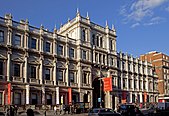
The MAUD Committee was a British scientific working group formed during the Second World War to determine if an atomic bomb was feasible. The name came from a reference by Danish physicist Niels Bohr to his housekeeper, Maud Ray. The committee was founded in response to the Frisch–Peierls memorandum, which argued that a small sphere of pure uranium-235 could have the explosive power of thousands of tons of TNT. Its chairman was George Thomson and it met at Burlington House (pictured). Uranium enrichment, fissile materials, and the design of nuclear reactors and nuclear weapons were examined. The research culminated in two reports, known collectively as the MAUD Report. In response, the British created a nuclear weapons project. The report was made available to the United States, where it energised the American effort, which eventually became the Manhattan Project; it was also handed to the Soviet Union by its atomic spies, helping start the Soviet atomic bomb project. (Full article...)
May 31
Scorpions are predatory arachnids of the order Scorpiones. They have eight legs, a pair of grasping pincers and a narrow, segmented tail, often carried in a characteristic forward curve over the back and always ending with a stinger. There are over 2,500 described species. They mainly live in deserts but have adapted to a wide range of environments. Most species give birth to live young, and the female cares for the juveniles while their exoskeletons harden, transporting them on her back. Scorpions primarily prey on insects and other invertebrates, but some species take vertebrates. They use their pincers to restrain and kill prey. Scorpions themselves are preyed on by larger animals. Their venomous sting can be used both for killing prey and for defense. Only about 25 species have venom capable of killing a human. In regions with highly venomous species, human fatalities regularly occur. Scorpions with their powerful stingers appear in art, folklore, mythology, and commercial brands. (Full article...)









